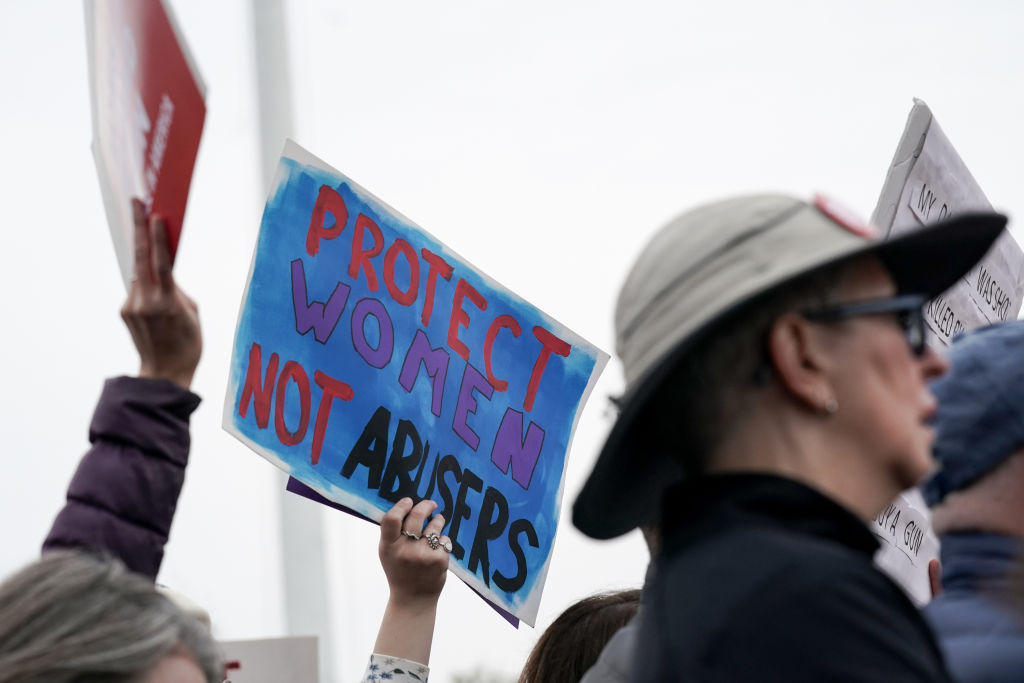The threat posed by violent abusers like Zackey Rahimi might be temporarily disarmed today, but the threat posed by the Supreme Court’s patriarchal agenda remains a loaded weapon.

Friday morning, the Supreme Court ruled 8-1 that a law restricting firearms access for a narrow class of individuals subject to a specific kind of domestic violence restraining order does not violate the Second Amendment. The ruling is a “win” in much the same way the Court’s ruling in the mifepristone case FDA v. Alliance for Hippocratic Medicine earlier this month is a win: The Court did the “bare minimum” necessary to cling to the last vestiges of its legitimacy.
As with the mifepristone case, the Supreme Court in Rahimi distanced itself from the unvarnished misogyny of the Fifth Circuit, which has been saying the quiet part too loud lately even for the most ardent conservatives on the Court, with the exception of Justice Thomas.
But just as Alliance for Hippocratic Medicine was a monster the Court itself created in Dobbs, Rahimi was a monster that the Court itself created in Bruen, and their losses are only temporary reprieves in the full-scale assault on women’s lives launched by those decisions.
As I wrote in my amicus brief in Rahimi, the Court’s decision in New York State Rifle & Pistol Association, Inc. v. Bruen must be understood in the context of its decision in Dobbs. While Bruen was ostensibly about guns and Dobbs ostensibly about abortion, both were, at their heart, about whose lives matter—and the answer in both cases was: not women’s.
- In Bruen, the conservative majority characterized the individual possession of firearms—instruments designed solely for the purpose of causing death and injury—as essential to the preservation of life.
- In Dobbs, the same majority characterized abortion—a process that protects women against death and injury—as uniquely destructive of life.
Because an individual right to own guns is no more spelled out in the Constitution than an individual right to an abortion is spelled out in the text of the Constitution, the Court had to invoke the concept of “self-defense” (which also does not appear in the Constitution) to justify expanding gun possession and use. When the Court made no reference to the self-defense consequences of obliterating the right against forced birth, it made clear that the “history and tradition” that guides its decisions is the history and tradition of choosing men’s fears over women’s lives.
Thus, it was entirely predictable that the Bruen decision would embolden violent men to assert an absolute constitutional right to terrorize their intimate partners with guns, just as it was entirely predictable that the Dobbs decision would embolden religious zealots to claim that their moral objections are sufficient to denying lifesaving medication to women. And yet Chief Justice Roberts’ majority opinion in Rahimi adopted a self-righteous, even affronted tone at the embarrassing excesses of lower court decisions: “Some courts,” he sniffed, “have misunderstood the methodology of our recent Second Amendment cases.”
While Bruen was ostensibly about guns and Dobbs ostensibly about abortion, both were, at their heart, about whose lives matter—and the answer in both cases was: not women’s.
But as Justice Jackson pointedly observed in her concurrence, the fault is “with us, not with them”: Courts have struggled to apply Bruen because “there is little method to Bruen’s madness.”
Jackson’s concurring opinion highlights the larger threat posed by the Roberts Court’s jurisprudence, which the decision in Rahimi does not neutralize: the “chaos” caused by the specious and selective “history and tradition” interpretive approach. In a break with the other conservatives, Justice Barrett also expressed her reservations about this method in her concurrence, stating that “evidence of ‘tradition’ unmoored from original meaning is not binding law.”
Justice Sotomayor’s concurring opinion expressed the stakes most directly. The “myopic focus on history and tradition,” she wrote, “fails to give full consideration to the real and present stakes of the problems facing our society today.” While history may be essential to constitutional analysis, “a rigid adherence to history, (particularly history predating the inclusion of women and people of color as full members of the polity), impoverishes constitutional interpretation and hamstrings our democracy.”
The threat posed by violent abusers like Zackey Rahimi might be temporarily disarmed today, but the threat posed by the Supreme Court’s patriarchal agenda remains a loaded weapon.
Up next:
U.S. democracy is at a dangerous inflection point—from the demise of abortion rights, to a lack of pay equity and parental leave, to skyrocketing maternal mortality, and attacks on trans health. Left unchecked, these crises will lead to wider gaps in political participation and representation. For 50 years, Ms. has been forging feminist journalism—reporting, rebelling and truth-telling from the front-lines, championing the Equal Rights Amendment, and centering the stories of those most impacted. With all that’s at stake for equality, we are redoubling our commitment for the next 50 years. In turn, we need your help, Support Ms. today with a donation—any amount that is meaningful to you. For as little as $5 each month, you’ll receive the print magazine along with our e-newsletters, action alerts, and invitations to Ms. Studios events and podcasts. We are grateful for your loyalty and ferocity.





